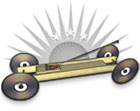Mouse Trap Vehicle: Rolling Friction
Earth shattering secrets for building record setting and winning mousetrap cars and racers. Here you will find all the latest and greatest untold construction secrets so you can build your very own mousetrap vehicle.
Purpose
To determine the amount of rolling friction acting against your mousetrap car and the coefficient of friction.
Equipment Needed
- Ruler (a caliper works better for smaller measurements)
- Smooth Ramp
- Tape Measure
Variables needed from other labs
- Starting potential energy
Discussion
Friction is a force that acts against the motion of all moving objects. Energy is required to overcome friction and keep an object moving. Mousetrap cars start with a limited supply of energy. This energy is used to overcome friction and propel the vehicle. The less friction acting against a moving mousetrap car, the less energy that is consumed to friction and the further that the vehicle will travel. A moving mousetrap car is affected by two type of friction: air friction and bearing friction. Air friction is a large factor only with cars that are moving fast and is nearly negligible for slow-moving distance cars; therefore, in this lab you will only take bearing friction into consideration. Bearing friction is actually caused by two surfaces rubbing against one another. The amount of friction depends on the materials that are doing the rubbing and the force pressing them together (Formula #3). In this lab you will find the combined force of friction from all bearings on your vehicle. This combined frictional force will be called the rolling friction. The smaller the coefficient of friction, the more efficient your mousetrap car and the greater the travel distance will be.
Finding the theoretical rolling friction requires placing your mousetrap car on a smooth and flat board or ramp. The ramp will be elevated from one end slowly until your mousetrap car "JUST" begins to roll at constant velocity. This point or angle is where the force pulling the car down the ramp is equal to the force of rolling friction acting against the car (Formula #2). The force pulling the car down the ramp is a combination of two forces: the force of gravity pulling straight down and the normal force of the ramp pushing back (Formula #4). As the angle of the ramp is increased, the normal force decreases (Formula #5). The force of gravity remains unchanged for all angles. The difference between the two forces causes the force down the ramp to increase. The greater the angle required to move the car, the more friction there will be acting against the car's motion. The angle is directly proportional to the force of friction or the coefficient of rolling friction. LOWER ANGLES are more desirable (Formula #7).
Fdown ramp = ƒfriction
formula 2: At a constant speed down the ramp the force [F] down the ramp is equal to the force of friction [ƒ].
ƒ = μN
formula 3: The force of friction [ƒ] depends on how slippery two surfaces are together called the coefficient of friction [μ] and how hard the surfaces are pressed together [N]. The coefficient is measured in newtons, the normal force in newtons, and the coefficient is newtons over newtons.
ƒ = sinθw
formula 4: the component of the weight [w] down the ramp is equal to the force of friction[ƒ].
N = cosθw
formula 5: the component of the weight [w] perpendicular to the ramp is equal to the normal force [N].
μ = (sinθw / cosθw) = tanθ
formula 6: combining formulas 3, 4, and 5 we find that the coefficient of friction [μ] is equal to tan the angle.
μ = tanθ
formula 7: the coefficient of friction is equal to tan the angle of the ramp.
Trigonometry
Trigonometry is a fancy type of mathematics that is based on simple relationships of all right triangles. Ancient mathematicians found that all right triangles are proportional by ratios of their sides and angles. These ratios times the angle are known as sine, cosine, and tangent. Knowing one of the angles other than the right angle-and any one of the sides to the triangle- will allow you can calculate everything else you would ever need to know about that triangle's sides or angles.
trigonometry: the force down [F] the ramp is a component of the normal force [N] and the weight [w].
Step 1:
Start by selecting a long and smooth board or ramp that will not bend or flex when lifted at one end. Your vehicle must fit on the ramp.
the set-up: a long board used as a ramp.
Step 2:
Measure the length of the board and record this measurement as the board length (L).
Board Length = _____ m
Step 3:
Place your vehicle on the ramp and begin lifting by one end. Slowly lift until the vehicle "JUST" begins to roll. Measure carefully and accurately the elevation of the board when the vehicle begins to roll and record this in the data table as the height (h). Repeat this process 5 to 10 times for more accurate results. (Note: You must subtract the thickness of the board from the height. Measure both ends of the ramp to correctly calculate the height.)
elevation height = _____ m
measure elevation: Measure carefully and accurately the elevation of the board when the vehicle begins to roll and record this in the data table as the height (h).
Step 4:
Calculate the angle for each trial using the following equation:
θ = (h / L) = sin-1
Angle = _____
Step 5:
From the derived formula, calculate the coefficient of friction for each trial. The coefficient of friction is directly proportional to the angle of the ramp. Smaller angles translate into greater travel distance.
μ = tanθ
coefficient of friction = _____
Step 6:
If this lab is performed correctly, the force of rolling friction acting against your car is equal to the force pulling the vehicle down the ramp in the elevated state. Calculate the force of friction by assuming that the force down the ramp is equal to the force of friction acting against the motion of your vehicle. Solve for the force down the ramp. MAKE SURE to use the weight of your vehicle in Newtons. If you have the mass in kilograms, you can calculate the weight by multiplying the mass of your vehicle by 9.8 m/s2 or find the weight by weighing your vehicle on a spring scale.
ƒ = sinθw
Force of rolling friction = _____ N
Step 7:
Using the starting energy you can calculate the predicted travel distance by using the following:
Predicted Travel Distance = PE / Frf
Predicted Travel Distance = _____ m
Step 8:
Test your results
*Can't find what you're looking for? Ask Doc Fizzix »




